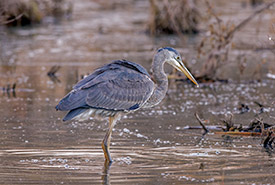On the flyway to home: Get to know Canada's migratory birds

Conservation Volunteers get a peek at migrating golden eagles (Photo by NCC)
Each spring, Canada's skies are filled with the sights and sounds of millions of birds arriving home from their southern wintering grounds. The four major migration pathways (flyways) in the Americas include:
|
From the Canadian Arctic to southern Mexico, these sky-high pathways span the continents and follow prominent natural features, such as coastlines, mountain ranges and river valleys. Some bird species only travel along one flyway, while species that are more widespread arrive in Canada via multiple migration routes. The Nature Conservancy of Canada (NCC) protects habitat for more than 300 migratory bird species, ensuring they have areas to rest and feed as well as habitat for nesting.

*Colour of the outline around the bird graphics indicate the flyway(s) that the species uses.
Get your printable copy of the NCC migratory bird map and species description.
Learn how to identify a few species from each flyway with these identificaiton cards: Pacific flyway, central flyway, Mississippi flyway and Atlantic flyway.
Learn about some of these returning bird species and where you may be able to spot them, below.
Pacific flyway
Lewis's woodpecker
From May to September, this endangered woodpecker can be found in BC's southern interior region.
Western sandpiper
Large flocks of these birds congregate in the Fraser River Delta in BC during spring and fall migration, with half a million counted in one day.
Golden eagle
From February to August, the golden eagle, the largest bird of prey in Canada, can be spotted during migration on many of NCC's properties. It is present year-round in some parts of Canada.
Central flyway
Sandhill crane
From March to November, sandhill cranes can be spotted across Canada’s grasslands, wetlands and meadows, including on NCC properties from Quebec to British Columbia.
McCown's longspur
From April to September, this ground-foraging songbird can be seen in dry, open prairies with short grass. NCC properties across Canada's prairies provide stopover and nesting habitat for this species.
Whooping crane
From April to September, this endangered species can be seen on several NCC properties in Saskatchewan.
Sprague's pipit
From April to August, this brownish-streaked, sparrow-sized bird can be found on many of NCC's grassland properties in Alberta, Saskatchewan and western Manitoba.
Atlantic flyway
Bicknell's thrush
From May to September, this sparrow-sized bird, with one of the most limited breeding and wintering ranges in North America, can be found on the summits of Green and White mountains in the Appalachians in Quebec, and in areas of New Brunswick and Nova Scotia.
Piping plover
From late April to August, this endangered shorebird can be seen dotting sand and pebble beaches and saline wetlands. NCC properties in Atlantic Canada and the Prairies provide stopover and nesting habitat for this species.
Semipalmated sandpiper
From May to September, semipalmated sandpipers migrate through Canada and the eastern United States — from the Canadian Arctic and the Hudson Bay lowlands — to make their 10,000-kilometre flight to their wintering grounds along the coasts of South America.
Mississippi flyway
From April to October, or year-round along the BC coast and occasionally in southern Canada, the great blue heron nests in every province except Newfoundland and Labrador. NCC properties across Canada provide stopover and nesting habitat for this species.
Prothonotary warbler
From April to September, this endangered, flashy yellow warbler can be found in southwestern Ontario, including on NCC's Backus Woods property. It is one of two warbler species in North America that nests in small tree cavities.
Bobolink
From May to September, this medium-sized songbird migrates from southern Canada and northern U.S. to its wintering grounds in southern South America — one of the world’s longest migrations (20,000 kilometres) of any North American songbird. It can be spotted across Canada on many NCC properties with grasslands.



















